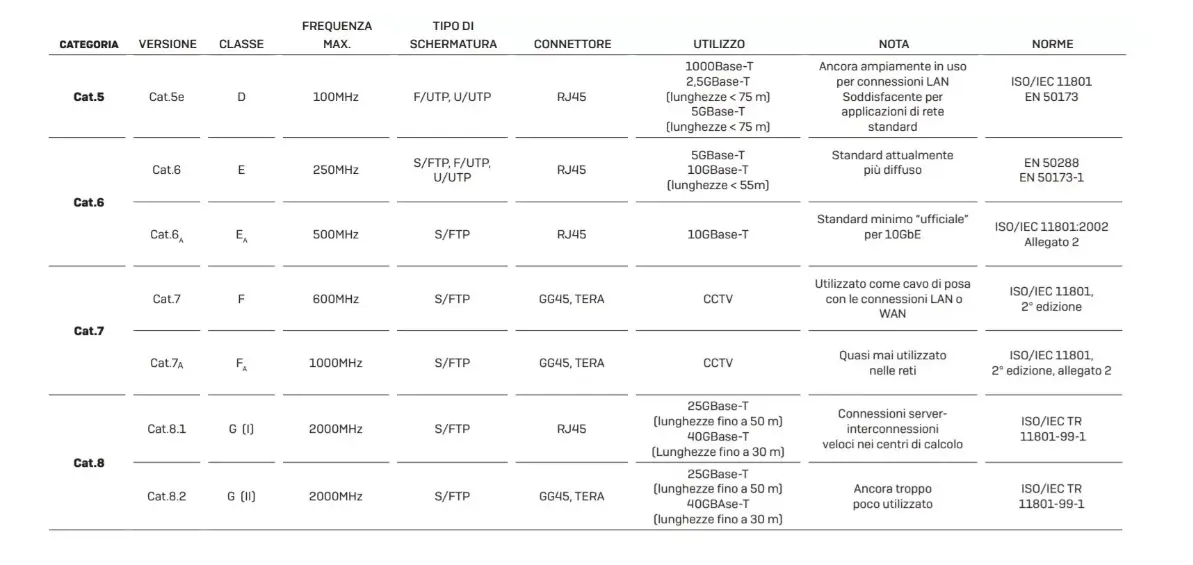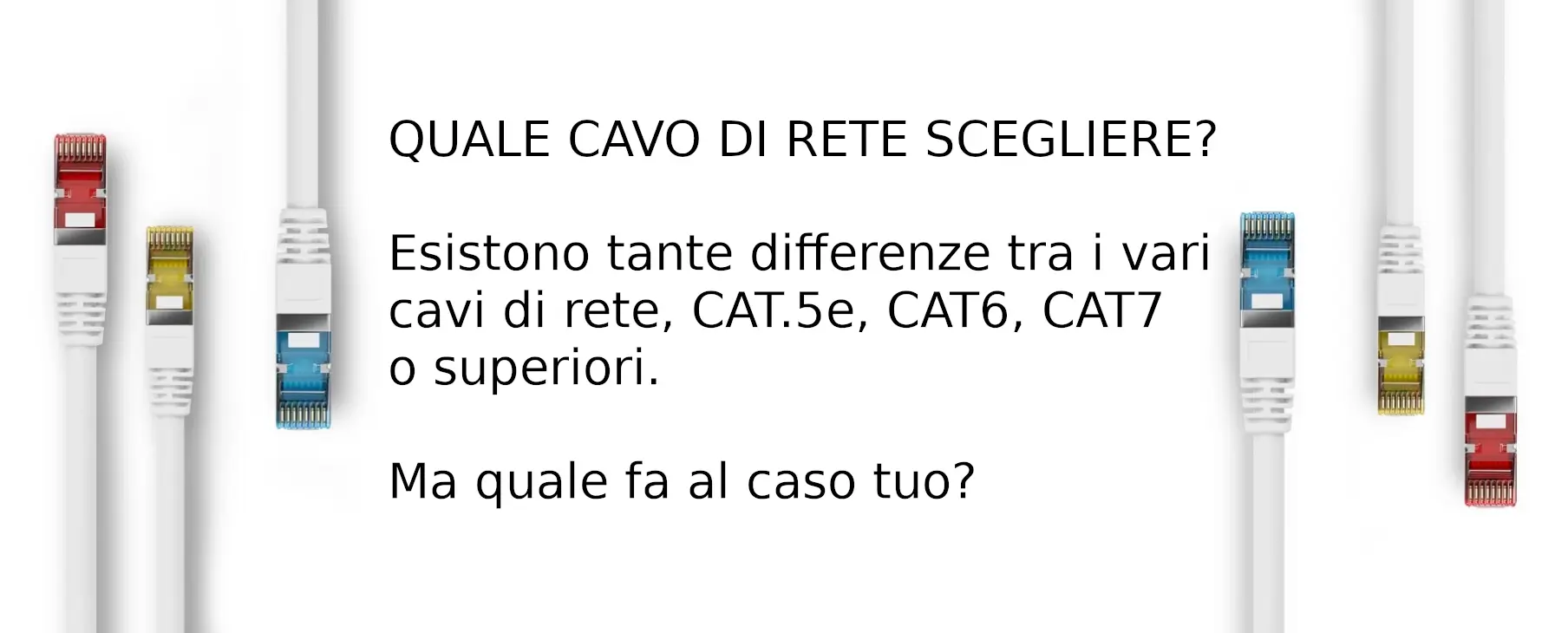Differences of LAN network cables
- 0 likes
- 833 views
- 0 comments

In order to make their characteristics easier to use, network cables have been divided into categories such as the most common, for example cat.5e, cat.6 , cat.7 and so on, with certain minimum requirements that must be met for the various applications and to be able to obtain the certifications.
The essential need for reliable and high-performance connectivity
The effects of digitization and technological progress in the world of work can no longer be overlooked. Thanks to this, we are witnessing the birth of new forms of work that rapidly impose themselves on the methods known up to now, as never before in the history of humanity. Back in the day, automation of office processes and tasks played a rather minor role and the amount of data and applications was much more limited.
As a result, everything was handled internally in the server rooms.
Globally active organizations used leased lines for certain limited periods of time to carry out data exchange and thus limit costs. Since then the situation has changed radically thanks to several factors.
Agility and flexibility are at the top of the list of priorities, because it is no longer conceivable that business processes and IT environments go against temporal and spatial barriers in the age of digital transformation. These aspects mark the world of work that is changing with digitalisation.
Work 4.0 and Smart Working are hallmarks of this change, even more so during these hard times caused by the COVID19 quarantines.
At a company level, digital and intelligent jobs take advantage of network connections to transmit processes, data and documents on a global scale, generating a huge and incredible volume of data in just a few seconds.
The cloud applications then, including the current Azure of Microsoft and AWS of Amazon, provide companies with large IT capabilities with a powerful front-end at very low cost for each user or application compared to traditional approaches, in addition to offer different packages for every type of customer need.
This reduces the risks for companies in terms of capital needs dependency, implementation, use and maintenance.
The transition from the on-premise model to the off-premise model and the consequent possibility of scaling future requirements and processes involves all companies and organizations, regardless of their size.
This change brings with it inevitable consequences .
One of these is the need to focus on connectivity, which must necessarily be reliable by following the strict certification standards. An IT or AV architecture based on off-premises and cloud computing with poor, unstable and therefore unreliable connections is a great risk when it comes to performing billions of transfer operations per second.
For the maximum performance of data centers and buildings, state-of-the-art products are required, especially with regard to the cabling infrastructure.
In the copper connectivity sector, more than ever, high performance, flexible and economical solutions are required, able to offer adequate bandwidth and be adapted according to a modular scheme to future needs.
With this in mind, patch cables deserve special attention because they represent the focal points of modern communication infrastructures, in order to meet the constantly growing performance requirements, as described above.
Therefore, the functioning and operation of entire company locations and the future digitization of the associated processes depend on their reliability. Efficient cabling is the physical basis for high-speed applications in offices and buildings. The unreliability of even a single patch cable can compromise the entire communication between the servers in charge of managing crucial business data and the functions to be used, with onerous consequences that can be easily avoided by correctly choosing the quality and performance class of the patch cables used.
Know the categories in detail: cable categories
The subdivision of network cables into categories 1 to 7 follows the general definition of classes A to G for links and transmission channels given in the ISO/IEC 11801 specification. The category always designates a single component of the channel of transmission. In this precise case, component means the cables, but they can also be, for example, the connection sockets or plugs and sockets, while the class designates the entire channel.
Above class F is the class G with subclasses I and II and similarly wiring categories 8, 8.1 and 8.2. For modern wiring techniques, the relevant standards are those starting from class D or Cat.5e because all the previous ones are no longer available on the market.
Standard consumer cables
Cat.5 network cables are used for transmission channels of class D and are used more frequently in current installations due to its low cost and good performance. They can transmit frequencies up to 100MHz and are distinguished in Cat.5 and Cat.5e.
If it is true that the Cat.5 supported Fast Ethernet technology with 100Mbit /s, since it was already no longer suitable for Gigabit Ethernet, was taken off the market; instead with the Cat. 5e an enhanced cable standard was developed, with appreciable NeXT and FeXT values, which can be used for 1000BaseT networks.
For use by private users and prosumers, it proves to be a cost-effective standard and is therefore still widely used.
Professional use
Category 6 cables are part of connection class E and EA with a consequent distinction between Cat.6 and Cat.6A ( Cat.6 augmented) for the transmission of frequencies up to 250 and 500 MHz.
The cables Cat.6 they are mainly used in data transmission networks with multimedia applications that involve a high network load.
To meet the bandwidth needs required by 10 Gigabit Ethernet, the Cat.6A for frequencies up to 500MHz over a maximum distance of 100m.
For this reason, modern installations designed for 10GBASE-T always require cables starting at least from Cat.6A .
Better shielding and fast transfer speed
Category 7, which is divided into Cat.7 and Cat.7A both for cables of the class F or class FA, is defined to support frequencies up to 600 and 1000MHz respectively and is based on a cable structure with 4 individually shielded pairs and an overall shielding.
Thanks to this increased shielding, category 7 cables are also suitable for meeting the needs that will concern future developments. For the first time, with Cat.7 new connectors have been included in the standard: Nexans GG45 backward compatible with RJ45 and Siemon's fully shielded TERA connector.
However, neither of the two connectors has managed to establish itself on the market, because the Cat.7 and modern 10GBASE-T network devices continue to use the extremely widespread RJ45 socket on all markets.
Standard at the highest level
with class I, which is defined with RJ45 connectors that are perfectly compatible with Cat.6A and class EA, and Cat 8.2 with class II , compatible and interoperable with Cat.7A and class FA with RJ45, GG45 or TERA connectors. Category 8 is designed for an operating frequency of up to a max. of 2000MHz. Cables in this category are suitable for the latest Ethernet standards, such as 25GBASE-T, 40GBASE-T and 100GBASE-T. Given the more limited range, these cables are usually used in computer centers to establish short connections between switches and routers.

Shielding and data structure
Twisted-pair cable typically consists of four pairs of wires (four pairs) twisted together. The twist serves to minimize the parasitic capacitance, which otherwise would strongly affect the transmission quality of the cable, especially in the high frequency bands with high signal attenuation values, which tends to occur when the pairs of wires are arranged in parallel.
The four pairs of wires are also twisted together in the cable to minimize near and far crosstalk between the pairs (NeXT and FeXT). This bundle of cables is called a core and is covered with a sheath.
Depending on the type of shielding, the individual pairs of wires, or core of the cable (or both or neither), are wrapped in a metal foil or protected by a braided shield.

The nomenclature of shielding
Before the uniform standardization with the ISO/IEC11801 standard, the designations of the shielding types were not uniform and often caused confusion on the market. This standard introduced a designation scheme.
Here is an example: S/FTP for TP cables with braid as overall shield and with shielding on individual pairs, or SF/FTP for TP cables with braid and foil as overall shield and foil as a single shield.
The shielding
Usually a ground connection that wraps around the core of the cable (total shield) or single pairs of wires (single shield) significantly improves the signal quality in terms of immunity to interference and radiation, interaction with other lines and security of interception of a transmission link.
This shield is then connected to the connectors via the metal housing of the connector, which establishes the connection to earth through the socket of the appliance.
Without shielding, this connection could not exist due to the galvanic isolation caused by the isolation transformers used in network technologies. In general, the following rule applies when it comes to shielding: the more shielded a cable is, the denser it is and therefore the more effective it is.
Even the shielding of individual wire pairs in this sense has clear and measurable positive effects. For this reason some higher cable categories (e.g. Cat.7) with their marked data transmission speed require cables with single and total shielding.
However, in the lower categories Cat.5e e Cat.6 usually completely unshielded cables are also used.

comments (0)